steering wheel Citroen C4 DAG 2014.5 2.G Owner's Manual
[x] Cancel search | Manufacturer: CITROEN, Model Year: 2014.5, Model line: C4 DAG, Model: Citroen C4 DAG 2014.5 2.GPages: 340, PDF Size: 12.89 MB
Page 4 of 340
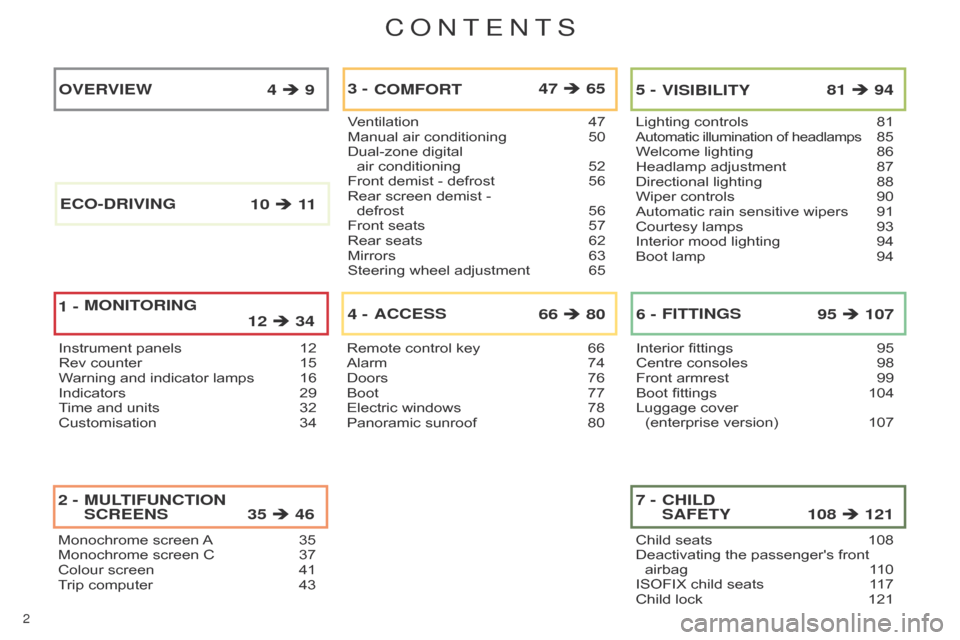
2
C4-2_en_Chap00a_sommaire_ed01-2014
Monochrome screen A 35
Monochrome screen C 37
Colour
screen
41
T
rip computer
43
2 - 35 46
MULTIFUNCTION
SCREENS
Ventilation 47
Manual air conditioning 50
Dual-zone
digital
air
conditioning
52
Front
demist - defrost
56
Rear
screen demist -
defrost
56
Front
seats
57
Rear
seats
62
Mirrors
63
Steering
wheel adjustment
65
COMFORT
3 -
47 65
Remote control key 66
Alarm 74
Doors
76
Boot
77
Electric
windows
78
Panoramic
sunroof
80
ACCESS
4 -
66 80
Lighting controls 81Automatic illumination of headlamps 85
Welcome
lighting
86
Headlamp
adjustment
87
Directional
lighting
88
Wiper
controls
90
Automatic
rain
sensitive
wipers
91
Courtesy
lamps
93
Interior
mood
lighting
94
Boot
lamp
94
5 - 81 94
VISIBILITY
Interior fittings 95
Centre consoles 98
Front
armrest
99
Boot
fittings
104
Luggage
cover
(enterprise
version)
107
6 - 95 107
FITTINGS
Instrument panels 12
Rev counter 15
W
arning and indicator lamps
16
Indicators
29
T
ime and units
32
Customisation
34
OVERVIEW 4 9
MONITORING
1 -
12 34
Child seats 108
Deactivating the passenger's front
airbag
1
10
ISOFIX
child seats
1
17
Child
lock
121
7 - 108 121
CHILD
SAFETY
E
CO
-
DRIVING
10
11
ConTEnTS
Page 8 of 340
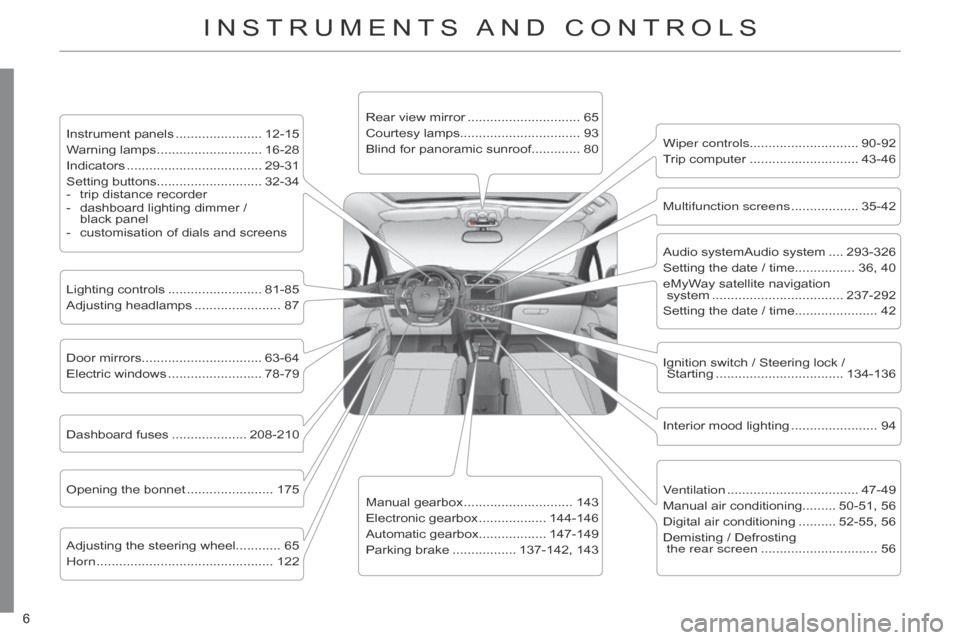
6
C4-2_en_Chap00b_vue-ensemble_ed01-2014
6
C4-2_en_Chap00b_vue-ensemble_ed01-2014
INSTRUMENTS AND CONTROLS
Instrument panels ....................... 12-15
W arning lamps ............................ 16-28
Indicators
.................................... 29-31
Setting
buttons............................ 32-34
-
trip
distance recorder
-
dashboard
lighting dimmer /
black
panel
-
customisation
of dials and screens
Lighting
controls
......................... 81-85
Adjusting
headlamps
....................... 87
Door
mirrors
................................ 63-64
Electric
windows
......................... 78-79
Dashboard
fuses
.................... 208-210
Opening
the bonnet
....................... 175
Adjusting
the steering wheel............ 65
Horn
............................................... 122 Audio
systemAudio system
.... 293-326
Setting
the date / time................ 36, 40
eMyWay
satellite navigation
system
................................... 237-292
Setting
the date / time...................... 42
Manual
gearbox
............................. 143
Electronic
gearbox
.................. 144-146
Automatic
gearbox.................. 147-149
Parking
brake
................. 137-142,
143Wiper controls............................. 90-92
Trip
computer
............................. 43-46
Rear
view mirror
.............................. 65
Courtesy
lamps................................ 93
Blind for panoramic sunroof............. 80
Interior
mood lighting
....................... 94
Ignition
switch / Steering lock /
Starting
.................................. 134-136
Multifunction screens
.................. 35-42
V
entilation
................................... 47-49
Manual
air conditioning......... 50-51, 56
Digital
air conditioning
.......... 52-55,
56
Demisting
/ Defrosting
the rear screen
............................... 56
Page 9 of 340

7
C4-2_en_Chap00b_vue-ensemble_ed01-2014
7
C4-2_en_Chap00b_vue-ensemble_ed01-2014
INSTRUMENTS AND CONTROLS
Multifunction steering wheel
Speed limiter........................... 162-163
Cruise control ......................... 164-165
Memorising
speeds
....................... 161
Black
panel (black screen)
.............. 33
Lighting
dimmer for instruments
...... 33
Courtesy
lamp on/off
....................... 93
Marking
space measurement
... 166-167 Audio
controls for Audio system .... 295
Audio
controls for eMyWay
............ 240
Audio
controls for
Audio
system
.... 295
Audio
controls for eMyWay
............ 240
OVERVIEW
Page 23 of 340

21
C4-2_en_Chap01_controle-de-marche_ed01-2014
Warning/indicator lampis onCause Action/Observations
Foot on the clutch** fixed.In
the STOP
mode of Stop &
Start,
changing to START
mode
is refused because the
clutch
pedal is not fully down.You
must declutch fully to allow the
change
to engine START
mode.
**
Only on the two-tone instrument panel without audio system.
Dynamic
stability control (DSC/ASR) flashing.
Regulation by the system is
active.
The
system optimises traction and
improves
the directional stability of the
vehicle.
fixed, associated with
illumination of
the
indicator lamp
in
the deactivation
button,
accompanied
by
an audible signal
and
a message.
The DSC/ASR or hill start assist system has a fault.Have
it checked by a CITROËN dealer or a
qualified workshop.
Power
steering fixed.The
power steering has a
fault. Drive
carefully at reduced speed.
Have
it checked by a CITROËN dealer or
a
qualified workshop.
Under-inflation fixed.
The
pressure in one or more
wheels
is too low. Check
the pressure of the tyres as soon
as
possible.
This
check should preferably be carried
out
when the tyres are cold.
+ flashing
then
fixed,
accompanied
by the Service warning
lamp. The
tyre pressure monitoring
system
has a fault or no
sensor
is detected on one of
the
wheels. Under-inflation
detection is not assured.
Have
the
system
checked
by
a
CITROËN
dealer
or a qualified workshop.
Directional
headlamps flashing.The
directional headlamps
system
has a fault. Have
it checked by a CITROËN dealer or
a
qualified workshop.
1
MONITORING
Page 35 of 340

33
C4-2_en_Chap01_controle-de-marche_ed01-2014
System allowing certain screens to be switched
off for night driving.
The
instrument
panel
remains
on
with
the
vehicle
speed,
electronic
or
auto
-
matic
gearbox
gear
selected,
cruise
control
or
speed
limiter
information,
if
in
use,
and
the
low
fuel
alerts
as
ap
-
propriate.
If
there
is
an
alert
or
a
change
in
a
function
or
to
a
setting,
the
black
panel
mode
is interrupted.
Black panel (black screen)
Activation
F
With
the
vehicle
lighting
on,
press
this
button
again
to
activate
the
black
panel.
F
Press
once
more
to
illu
minate
on
the
various screens again.
Permits manual adjustment of the bright -
ness of the instruments and controls in relation
to
the
exterior
brightness.
Only operates
when
the
vehicle
lighting
is
on
in night
mode.
Lighting dimmer
Activation
F
Press button
A
to
change
the
bright
-
ness
of the instruments and controls.
F
When
the
lighting
reaches
the
mini
-
mum
setting,
release
the
button,
then
press again to increase it.
or
F
When
the
lighting
reaches
the
maxi
-
mum
setting,
release
the
button,
then
press again to reduce it.
F
When
the
lighting
reaches
the
level
of
brightness
required,
release
the
button.Deactivation
When
the
vehicle
lighting
is
of
f,
or
in
day
mode
(daytime
running
lamps
on),
pressing
the
button
or
turning
the
thumb
wheel does not have any effect.
You
can also modify the level of lighting
by
turning
the
thumb
wheel
B
,
located
on
the left of the steering wheel:
F
upwards;
to reduce the level,
F
downwards;
to increase the level.
This
indicator
and
the
lighting
value
appear
in
the
middle
of
the
instrument
panel
during
adjustment
to
show
the
lighting
level
compared
to
the
16
levels
avail
-
able.
1
MONITORING
Page 67 of 340

33
65
C4-2_en_Chap03_confort_ed01-2014
Automatic day/night model
By
means
of
a
sensor
,
which
measures
the
light
from
the
rear
of
the
vehicle,
this
system
automatically
and
progres
-
sively
changes
between
the
day
and
night
uses.In
order
to
ensure
optimum
vis
-
ibility
during
your
manoeuvres,
the
mirror
lightens
automatically
when
reverse gear is engaged.STEERING WHEEL AD j USTMENT
F When stationary, pull the control
lever to release the adjustment
mechanism.
F
Adjust
the
height
and
reach
to
suit
your
driving position.
F
Push
the
control
lever
to
lock
the
adjustment
mechanism.
a
s a safety precaution, these
operations
should
only
be
carried out
with the vehicle stationary.
Rear view mirror
Adjustable mirror providing a central rearward
view.
Equipped
with
an
anti-dazzle
system,
which
darkens
the
mirror
glass
and
re
-
duces
the
nuisance
to
the
driver
caused
by
the
sun,
headlamps
from
other
ve
-
hicles...
Manual day/night model
Adjustment
F
Adjust
the
mirror
so
that
the
glass
is
directed
correctly in the "day" position.
Day/night position
F
Pull
the
lever
to
change
to
the
"night"
anti-dazzle position.
F
Push
the
lever
to
change
to
the
normal
"day" position.
COMFORT
Page 91 of 340
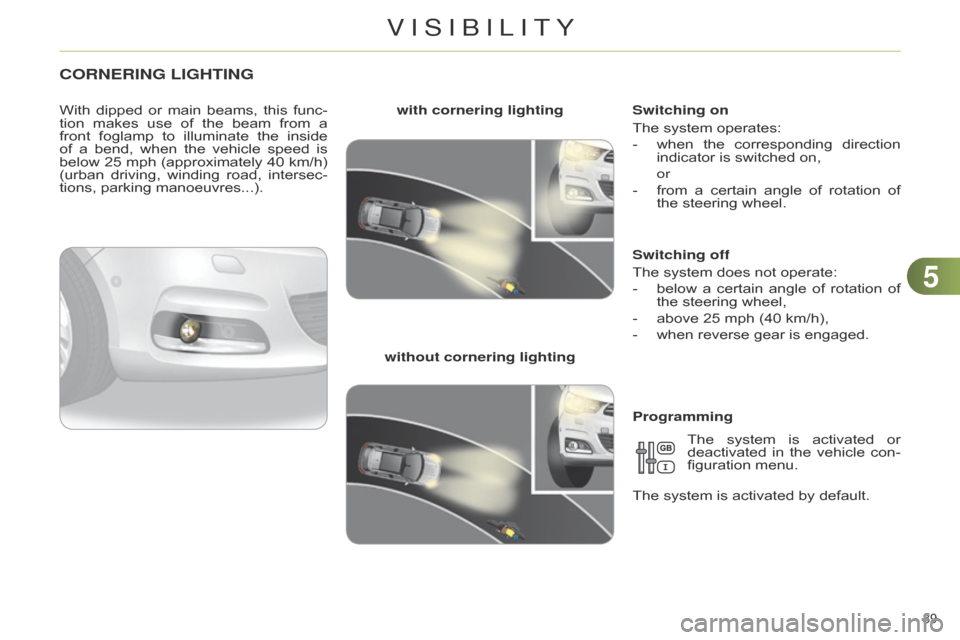
55
89
C4-2_en_Chap05_visibilite_ed01-2014
CORNERING LIGHTING
With dipped or main beams, this func -
tion makes use of the beam from a
front
foglamp
to
illu
minate
the
inside
of
a
bend,
when
the
vehicle
speed
is
below
25
mph
(approximately
40
km/h)
(urban
driving,
winding
road,
intersec
-
tions,
parking manoeuvres...). with cornering lighting
without cornering lighting Switching on
The
system operates:
-
when
the
corresponding
direction
indicator
is switched on,
or
-
from
a
certain
angle
of
rotation
of
the
steering wheel.
Switching off
The
system does not operate:
-
below
a
certain
angle
of
rotation
of
the
steering wheel,
-
above
25 mph (40 km/h),
-
when
reverse gear is engaged.
Programming The
system
is
activated
or
deactivated
in
the
vehicle
con
-
figuration
menu.
The
system is activated by default.
VISIBILITY
Page 124 of 340
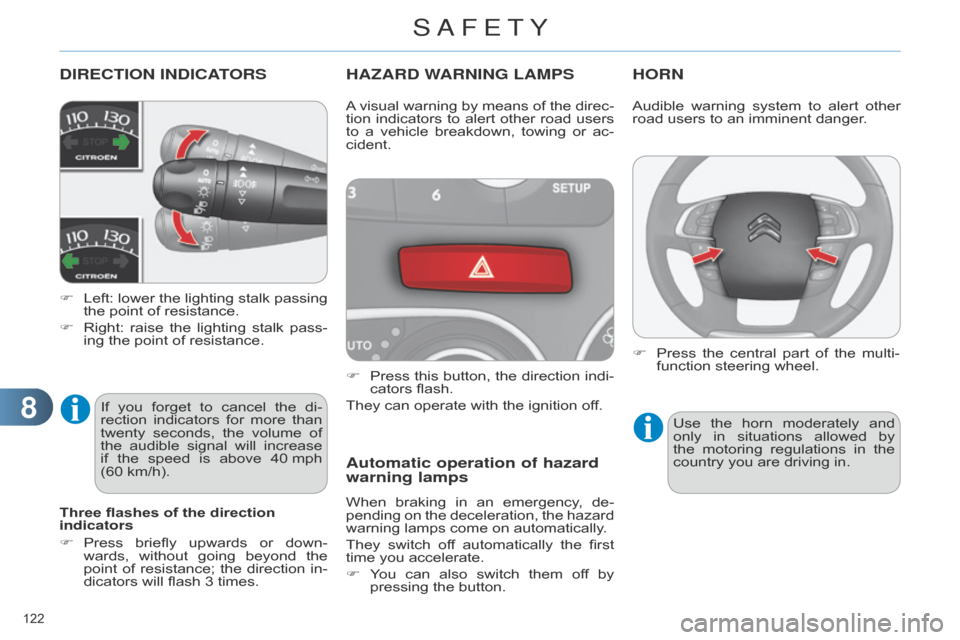
88
122
C4-2_en_Chap08_securite_ed01-2014
DIRECTION INDICATORS
F Left: lower the lighting stalk passing the
point of resistance.
F
Right:
raise
the
lighting
stalk
pass
-
ing
the point of resistance.
HAZARD WARNING LAMPS
F Press this button, the direction indi -
cators flash.
They
can operate with the ignition off.
Automatic operation of hazard
warning lamps
When braking in an emergency , de -
pending on the deceleration, the hazard
warning
lamps come on automatically.
They
switch
of
f
automatically
the
first
time
you accelerate.
F
Y
ou
can
also
switch
them
of
f
by
pressing
the button.
HORN
A visual warning by means of the direc -
tion indicators to alert other road users
to
a
vehicle
breakdown,
towing
or
ac
-
cident.
Three flashes of the direction
indicators
F
Press
briefly
upwards
or
down
-
wards,
without
going
beyond
the
point
of
resistance;
the
direction
in
-
dicators
will
flash
3
times.
If
you
forget
to
cancel
the
di
-
rection
indicators
for
more
than
twenty
seconds,
the
volume
of
the
audible
signal
will
increase
if
the
speed
is
above
40
mph
(60
km/h). Audible
warning system to alert other road
users to an imminent danger.
Use
the
horn
moderately
and
only
in
situations
allowed
by
the
motoring
regulations
in
the
country
you are driving in.
F
Press
the
central
part
of
the
multi
-
function
steering wheel.
SAFETY
Page 126 of 340
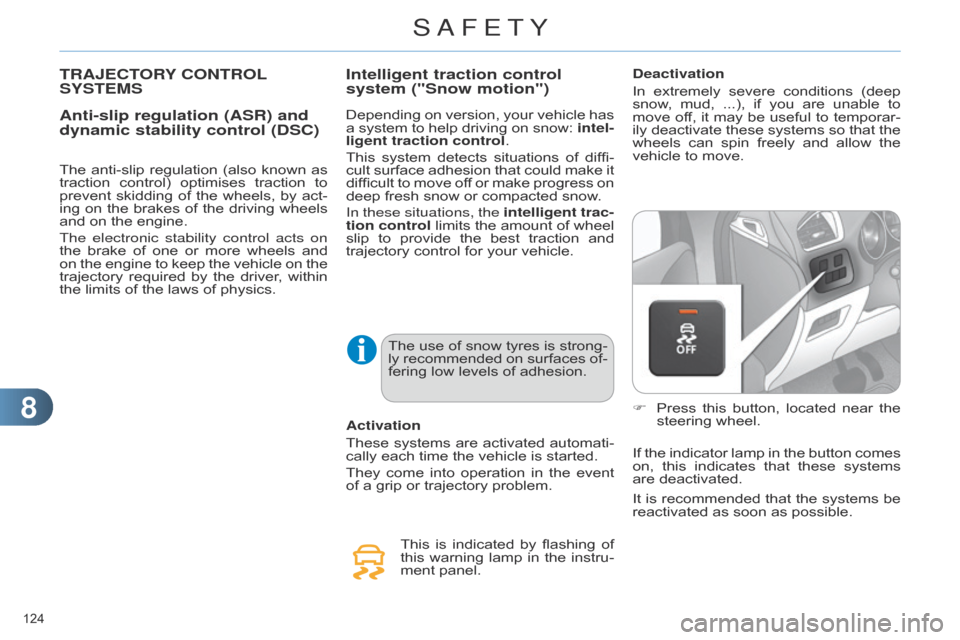
88
124
C4-2_en_Chap08_securite_ed01-2014
TRAjECTORY CONTROL SYSTEMS
Anti-slip regulation (ASR) and
dynamic stability control (DSC)
The anti-slip regulation (also known as traction
control) optimises traction to
prevent
skidding
of
the
wheels,
by
act
-
ing
on
the
brakes
of
the
driving
wheels
and
on the engine.
The electronic stability control acts on
the
brake
of
one
or
more
wheels
and
on
the
engine
to
keep
the
vehicle
on
the
trajectory
required
by
the
driver
,
within
the
limits of the laws of physics.
Activation
These
systems
are
activated
automati
-
cally
each time the vehicle is started.
They
come
into
operation
in
the
event
of
a grip or trajectory problem.
This
is
indicated
by
flashing
of
this
warning
lamp
in
the
instru
-
ment
panel.
Intelligent traction control
system ("Snow motion")Deactivation
In
extremely
severe
conditions
(deep
snow
,
mud,
...),
if
you
are
unable
to
move
of
f,
it
may
be
useful
to
temporar
-
ily
deactivate
these
systems
so
that
the
wheels
can
spin
freely
and
allow
the
vehicle
to move.
F
Press
this
button,
located
near
the
steering
wheel.
If
the
indicator
lamp
in
the
button
comes
on,
this
indicates
that
these
systems
are
deactivated.
Depending
on
version,
your
vehicle
has
a
system
to
help
driving
on
snow:
intel
-
ligent traction control.
This
system
detects
situations
of
diffi
-
cult
surface
adhesion
that
could
make
it
difficult
to
move
of
f
or
make
progress
on
deep
fresh
snow
or
compacted
snow.
In these situations, the intelligent trac-
tion control
limits
the
amount
of
wheel
slip
to
provide
the
best
traction
and
trajectory
control
for
your
vehicle.
The
use
of
snow
tyres
is
strong-
ly
recommended
on
surfaces
of
-
fering
low
levels
of
adhesion. It
is
recommended
that
the
systems
be
reactivated
as soon as possible.
SAFETY
Page 131 of 340
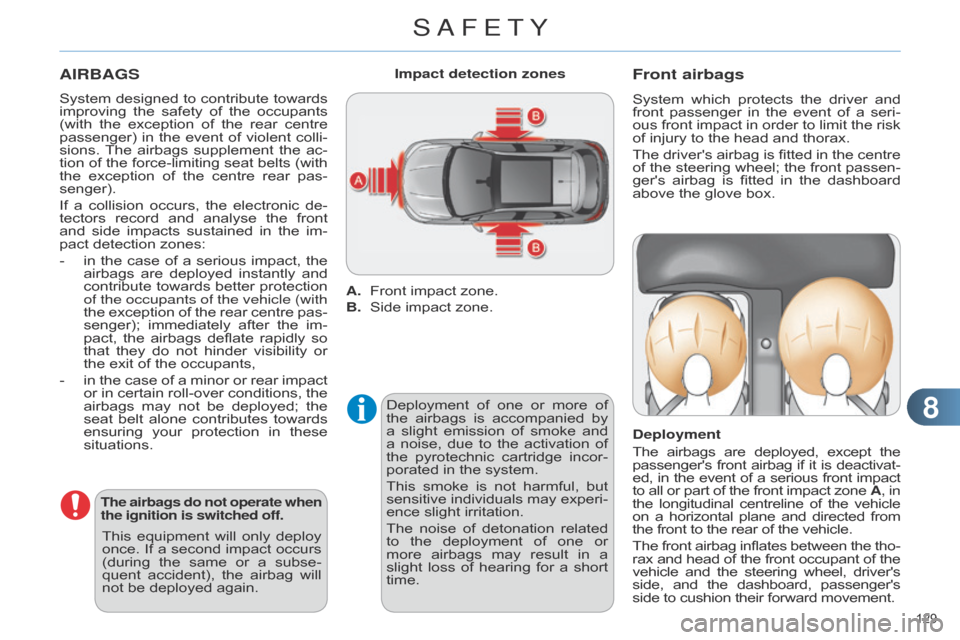
88
129
C4-2_en_Chap08_securite_ed01-2014
AIRBAGS
System designed to contribute towards improving
the safety of the occupants
(with
the
exception
of
the
rear
centre
passenger)
in
the
event
of
violent
colli-
sions.
The
airbags
supplement
the
ac
-
tion
of
the
force-limiting
seat
belts
(with
the
exception
of
the
centre
rear
pas
-
senger).
If
a
collision
occurs,
the
electronic
de
-
tectors
record
and
analyse
the
front
and
side
impacts
sustained
in
the
im
-
pact
detection zones:
-
in
the
case
of
a
serious
impact,
the
airbags
are
deployed
instantly
and
contribute
towards
better
protection
of the occupants of the vehicle (with
the
exception
of
the
rear
centre
pas
-
senger);
immediately
after
the
im
-
pact,
the
airbags
deflate
rapidly
so
that
they
do
not
hinder
visibility
or
the
exit of the occupants,
-
in
the
case
of
a
minor
or
rear
impact
or
in
certain
roll-over
conditions,
the
airbags
may
not
be
deployed;
the
seat
belt
alone
contributes
towards
ensuring
your
protection
in
these
situations.
The airbags do not operate when
the ignition is switched off.
A. Front impact zone.
B.
Side
impact zone.
Impact detection zones
Deployment
of
one
or
more
of
the
airbags
is
accompanied
by
a
slight
emission
of
smoke
and
a
noise,
due
to
the
activation
of
the
pyrotechnic
cartridge
incor
-
porated
in the system.
This
smoke
is
not
harmful,
but
sensitive
individuals
may
experi
-
ence
slight irritation.
The
noise
of
detonation
related
to
the
deployment
of
one
or
more
airbags
may
result
in
a
slight
loss
of
hearing
for
a
short
time.
Front airbags
System which protects the driver and front
passenger in the event of a seri -
ous
front
impact
in
order
to
limit
the
risk
of
injury to the head and thorax.
The
driver's
airbag
is
fitted
in
the
centre
of
the
steering
wheel;
the
front
passen
-
ger's
airbag
is
fitted
in
the
dashboard
above
the glove box.
Deployment
The
airbags
are
deployed,
except
the passenger's
front
airbag
if
it
is
deactivat
-
ed,
in
the
event
of
a
serious
front
impact to
all
or
part
of
the
front
impact
zone
A, in
the
longitudinal
centreline
of
the
vehicle on
a
horizontal
plane
and
directed
from the
front to the rear of the vehicle.
The
front
airbag
inflates
between
the
tho
-
rax
and
head
of
the
front
occupant
of
the vehicle
and
the
steering
wheel,
driver's side,
and
the
dashboard,
passenger's side
to cushion their forward movement.
This
equipment
will
only
deploy
once.
If
a
second
impact
occurs
(during
the
same
or
a
subse
-
quent
accident),
the
airbag
will
not
be
deployed
again.
SAFETY